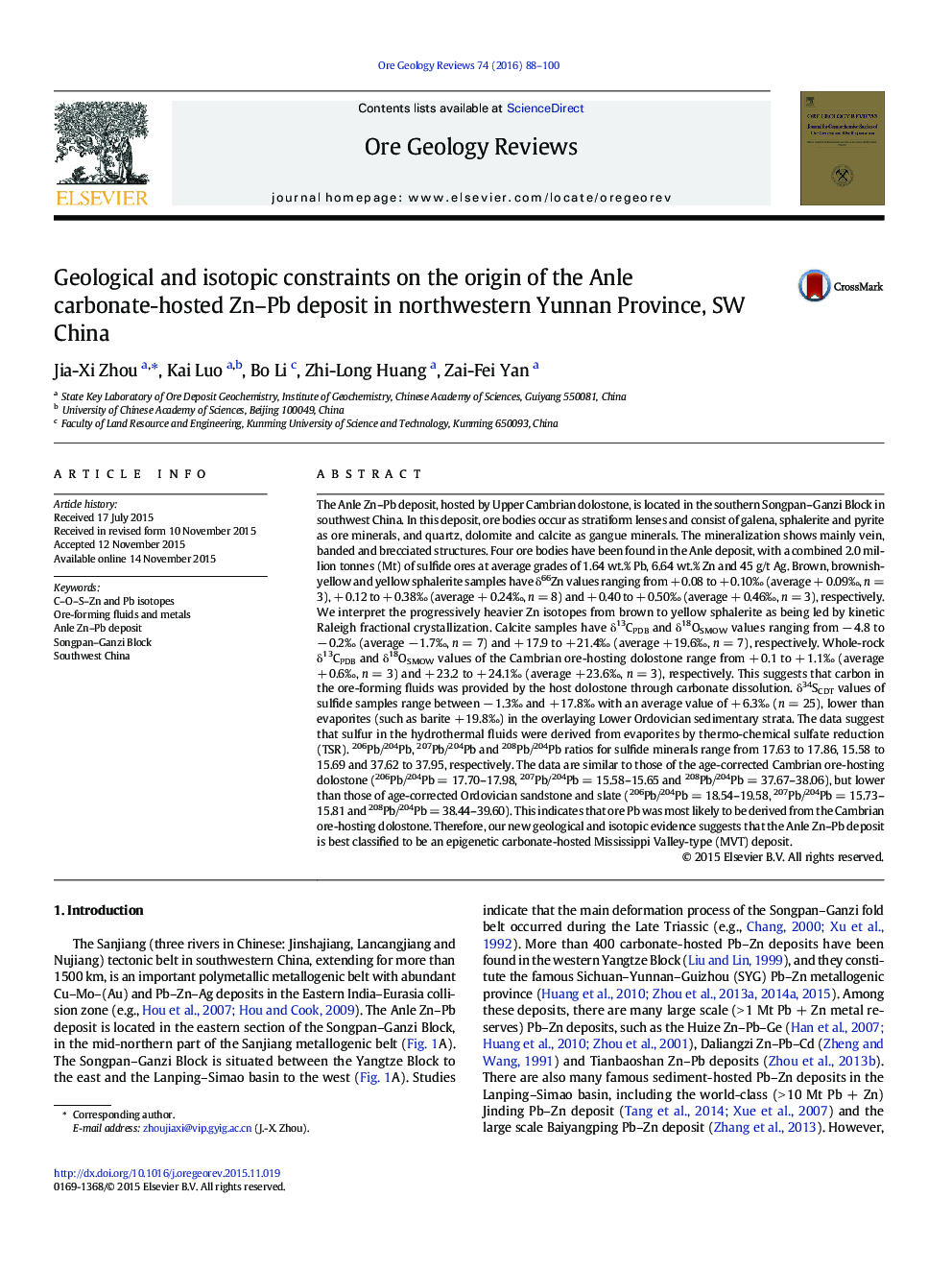| کد مقاله | کد نشریه | سال انتشار | مقاله انگلیسی | نسخه تمام متن |
|---|---|---|---|---|
| 4696826 | 1637232 | 2016 | 13 صفحه PDF | دانلود رایگان |

• Sulfur may have been derived from evaporites.
• Carbon and metals may have been sourced from the ore-hosting dolostone that was affected by the Songpan–Ganzi orogenic event.
• Zn isotopes can't be used as useful tracers for ore-forming metals and discriminators for metallogenic setting.
• The Anle Zn–Pb deposit can be assigned to be an epigenetic MVT deposit.
The Anle Zn–Pb deposit, hosted by Upper Cambrian dolostone, is located in the southern Songpan–Ganzi Block in southwest China. In this deposit, ore bodies occur as stratiform lenses and consist of galena, sphalerite and pyrite as ore minerals, and quartz, dolomite and calcite as gangue minerals. The mineralization shows mainly vein, banded and brecciated structures. Four ore bodies have been found in the Anle deposit, with a combined 2.0 million tonnes (Mt) of sulfide ores at average grades of 1.64 wt.% Pb, 6.64 wt.% Zn and 45 g/t Ag. Brown, brownish-yellow and yellow sphalerite samples have δ66Zn values ranging from + 0.08 to + 0.10‰ (average + 0.09‰, n = 3), + 0.12 to + 0.38‰ (average + 0.24‰, n = 8) and + 0.40 to + 0.50‰ (average + 0.46‰, n = 3), respectively. We interpret the progressively heavier Zn isotopes from brown to yellow sphalerite as being led by kinetic Raleigh fractional crystallization. Calcite samples have δ13CPDB and δ18OSMOW values ranging from − 4.8 to − 0.2‰ (average − 1.7‰, n = 7) and + 17.9 to + 21.4‰ (average + 19.6‰, n = 7), respectively. Whole-rock δ13CPDB and δ18OSMOW values of the Cambrian ore-hosting dolostone range from + 0.1 to + 1.1‰ (average + 0.6‰, n = 3) and + 23.2 to + 24.1‰ (average + 23.6‰, n = 3), respectively. This suggests that carbon in the ore-forming fluids was provided by the host dolostone through carbonate dissolution. δ34SCDT values of sulfide samples range between − 1.3‰ and + 17.8‰ with an average value of + 6.3‰ (n = 25), lower than evaporites (such as barite + 19.8‰) in the overlaying Lower Ordovician sedimentary strata. The data suggest that sulfur in the hydrothermal fluids were derived from evaporites by thermo-chemical sulfate reduction (TSR). 206Pb/204Pb, 207Pb/204Pb and 208Pb/204Pb ratios for sulfide minerals range from 17.63 to 17.86, 15.58 to 15.69 and 37.62 to 37.95, respectively. The data are similar to those of the age-corrected Cambrian ore-hosting dolostone (206Pb/204Pb = 17.70–17.98, 207Pb/204Pb = 15.58–15.65 and 208Pb/204Pb = 37.67–38.06), but lower than those of age-corrected Ordovician sandstone and slate (206Pb/204Pb = 18.54–19.58, 207Pb/204Pb = 15.73–15.81 and 208Pb/204Pb = 38.44–39.60). This indicates that ore Pb was most likely to be derived from the Cambrian ore-hosting dolostone. Therefore, our new geological and isotopic evidence suggests that the Anle Zn–Pb deposit is best classified to be an epigenetic carbonate-hosted Mississippi Valley-type (MVT) deposit.
Figure optionsDownload as PowerPoint slide
Journal: Ore Geology Reviews - Volume 74, April 2016, Pages 88–100